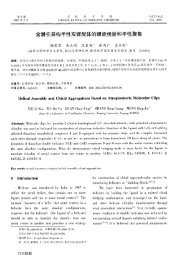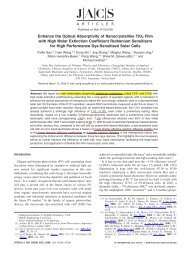Aerobic oxidation of alcohols over carbon nanotube-supported Ru ...
Aerobic oxidation of alcohols over carbon nanotube-supported Ru ...
Aerobic oxidation of alcohols over carbon nanotube-supported Ru ...
Create successful ePaper yourself
Turn your PDF publications into a flip-book with our unique Google optimized e-Paper software.
136 X. Yang et al. / Applied Catalysis A: General 382 (2010) 131–137Scheme 2. Possible reaction mechanism <strong>of</strong> benzyl alcohol <strong>oxidation</strong> <strong>over</strong> the <strong>supported</strong>ruthenium catalysts.amount <strong>of</strong> water increases, more interfaces would be available,which results in an increase in the conversion <strong>of</strong> substrate. Thesolubility <strong>of</strong> benzaldehyde in toluene is higher than that <strong>of</strong> benzylalcohol, but its solubility is much lower in water than that<strong>of</strong> benzyl alcohol. Toluene extracts benzaldehyde to the organicphase, avoiding further <strong>oxidation</strong>. As such, a maximum yield canbe obtained at a proper water/toluene ratio. A model is proposedand shown in Scheme 1. Following the classical dehydrogenationmechanism <strong>of</strong> alcohol <strong>oxidation</strong>, the possible reaction steps <strong>of</strong> the<strong>oxidation</strong> <strong>of</strong> benzyl alcohol are shown in Scheme 2. The O–H bond<strong>of</strong> benzyl alcohol breaks upon adsorption at the surface sites, yieldingan adsorbed alkoxide and hydrogen [32]. For the adsorbedalkoxide, the -C–H bond is weaker than other C–H bonds dueto the electron-withdrawing effect <strong>of</strong> the oxygen atom, resultingin the preferential breaking <strong>of</strong> the -C–H bond that is the ratedeterminingstep [33], as shown in Scheme 2. Meanwhile, adsorbedactivated oxygen is necessary to oxidize the hydrogen co-product,which helps to shift the equilibrium toward the <strong>carbon</strong>yl compoundand to accelerate the whole reaction by liberating surfacemetallic sites [34], as schematically shown in Scheme 2. A similarmultiphase reaction system was proposed and discussed before[35,36].The <strong>oxidation</strong> <strong>of</strong> other activated and non-activated <strong>alcohols</strong>was also tested in the presence <strong>of</strong> water (Table 4). Four <strong>of</strong> these<strong>alcohols</strong> contain a sulfur or nitrogen atom, or a <strong>carbon</strong>–<strong>carbon</strong>double bond (entries 4–6). The reaction selectivity is 100% in allcases, and all primary and secondary benzylic <strong>alcohols</strong> are convertedinto the corresponding benzaldehydes and ketones. Primaryallylic alcohol (typical cinnamyl alcohol) affords the correspondingenal (cinnamaldehyde) without intramolecular hydrogen transferor geometrical isomerization <strong>of</strong> the double bond. The <strong>Ru</strong>/CNTs systemalso catalyzes the <strong>oxidation</strong> <strong>of</strong> <strong>alcohols</strong> containing nitrogen orsulfur atoms to the corresponding aldehydes in high yields (entries5 and 6), while monomeric <strong>Ru</strong> complexes cannot effect catalytic<strong>oxidation</strong> <strong>of</strong> these <strong>alcohols</strong> because <strong>of</strong> strong coordination to themetal center [37]. Alicyclic <strong>alcohols</strong> such as cyclopentanol andcyclohexanol are selectively oxidized to the corresponding cyclicketones (entries 8 and 9). Less reactive aliphatic <strong>alcohols</strong> such as 1-octanol and 2-octanol are also oxidized (entries 10 and 11). Whenair is used as oxidant instead <strong>of</strong> pure O 2 , the conversion <strong>of</strong> benzylalcohol remains at the same level, demonstrating that the efficientselective <strong>oxidation</strong> <strong>of</strong> benzyl alcohol <strong>over</strong> the as-made <strong>Ru</strong>/CNTs catalystscan be realized in air, which is <strong>of</strong> great potential for industrialapplications. When the <strong>oxidation</strong> <strong>of</strong> benzyl alcohol is repeated 4times with the same catalyst <strong>of</strong> <strong>Ru</strong>/CNTs, the conversion <strong>of</strong> benzylalcohol remains 92% without any obvious loss in activity, indicatingthat the <strong>Ru</strong>/CNTs catalyst has excellent stability.4. ConclusionsEffective catalytic <strong>oxidation</strong> <strong>of</strong> <strong>alcohols</strong> under mild conditionshas been realized in an emulsion system, in which CNT-<strong>supported</strong>ruthenium composites function both as catalysts and as emulsifyingagents. <strong>Ru</strong>/CNTs catalysts are prepared by the traditionalwetness impregnation method, and show excellent activity, selectivity,and stability for the selective <strong>oxidation</strong> <strong>of</strong> benzyl alcohol withoxygen or air as oxidant. The catalytic activity <strong>of</strong> <strong>Ru</strong>/CNTs for theselective <strong>oxidation</strong> <strong>of</strong> benzyl alcohol is greatly enhanced by water,which is due to the formation <strong>of</strong> emulsion droplets where the CNT<strong>supported</strong>catalysts assemble at the interfaces. <strong>Ru</strong>/CNTs catalystsare <strong>of</strong> potential for the selective <strong>oxidation</strong> <strong>of</strong> a large variety <strong>of</strong><strong>alcohols</strong> in the presence <strong>of</strong> water. Furthermore, the catalyst canbe easily separated and recycled by sedimentation.The results reported here also highlight the unique propertyand functions <strong>of</strong> solid catalysts assembled at the interfaces <strong>of</strong> twoliquid phases to form special emulsion catalysis systems, whichleads one to anticipate that such emulsion-stabilizing solid catalystsafter being further tailored will be <strong>of</strong> wide use in a broad range<strong>of</strong> reactions.AcknowledgementsThis work is partly <strong>supported</strong> by NSFC (Nos. 20725619,20836002). We thank Pr<strong>of</strong>. Roel Prins at ETH, Switzerland, and Dr.Dangsheng Su at Fritz Haber Institute <strong>of</strong> the Max Planck Society,Germany, for helpful discussions and suggestions.Appendix A. Supplementary dataSupplementary data associated with this article can be found, inthe online version, at doi:10.1016/j.apcata.2010.04.046.References[1] W.J. Mijs, C.R.H. de Jonge, Organic Syntheses by Oxidation with Metal Compounds,Plenum, New York, 1986.[2] M. Hudlicky, Oxidations in Organic Chemistry, ACS Monograph 186, ACS, Washington,DC, 1990.[3] K. Yamaguchi, K. Mori, T. Mizugaki, K. Ebitani, K. Kaneda, J. Am. Chem. Soc. 122(2000) 7144–7145.[4] K. Mori, K. Yamaguchi, T. Hara, T. Mizugaki, K. Ebitani, K. Kaneda, J. Am. Chem.Soc. 124 (2002) 11572–11573.[5] K. Mori, T. Hara, T. Mizugaki, K. Ebitani, K. Kaneda, J. Am. Chem. Soc. 126 (2004)10657–10666.[6] K. Yamaguchi, N. Mizuno, Angew. Chem. Int. Ed. 41 (2002) 4538–4542.[7] A. Abad, C. Concepción, A. Corma, H. García, Angew. Chem. Int. Ed. 44 (2005)4066–4069.[8] D.I. Enache, J.K. Edwards, P. Landon, B. Solsona-Espriu, A.F. Carley, A.A. Herzing,M. Watanabe, C.J. Kiely, D.W. Knight, G.J. Hutchings, Science 311 (2006)362–365.[9] H.-B. Ji, K. Ebitani, T. Mizugaki, K. Kaneda, Catal. Commun. 3 (2002) 511–517.[10] S. Martín, D.F. Suárez, Tetrahedron Lett. 43 (2002) 4475–4479.[11] K.S. Colemane, M. Coppe, C. Thomas, J.A. Osborn, Tetrahedron Lett. 40 (1999)3723–3726.[12] J. Muldoon, S.N. Brown, Org. Lett. 4 (2002) 1043–1045.[13] F. Minisci, C. Punta, F. Recupero, F. Fontana, G.F. Peduli, Chem. Commun. (2002)688–689.[14] F. Minisci, F. Recupero, A. Cecchetto, C. Gambarotti, C. Punta, R. Faletti, R.Paganelli, G.F. Pedulli, Eur. J. Org. Chem. (2004) 109–119.[15] C. Dekker, Phys. Today 52 (1999) 22–28.[16] J. Kong, N.R. Franklin, C.W. Zhou, M.G. Chapline, S. Peng, K.J. Cho, H.J. Dai, Science287 (2000) 622–625.[17] J.M. Planeix, N. Coustel, B. Coq, V. Brotons, P.S. Kumbhar, R. Dutartre, P. Geneste,P. Bernier, P.M. Ajayan, J. Am. Chem. Soc. 116 (1994) 7935–7936.[18] A. Chambers, T. Nemes, N.M. Rodriguez, R.T.K. Baker, J. Phys. Chem. B 102 (1998)2251–2258.[19] W.Z. Li, C.H. Liang, J.S. Qiu, W.J. Zhou, H.M. Han, Z.B. Wei, G.Q. Sun, Q. Xin, Carbon40 (2002) 791–794.[20] C.H. Liang, Z.L. Li, J.S. Qiu, C. Li, J. Catal. 211 (2002) 278–282.[21] J.S. Qiu, H.Z. Zhang, C.H. Liang, J.W. Li, Z.B. Zhao, Chem. Eur. J. 12 (2006)2147–2151.[22] C. Wang, J.S. Qiu, C.H. Liang, L. Xing, X.M. Yang, Catal. Commun. 9 (2008)1749–1753.[23] J. Zhang, X. Liu, R. Blume, A. Zhang, R. Schlögl, D.S. Su, Science 322 (2008) 73–77.[24] R.A. DallaBetta, J. Catal. 34 (1974) 57–60.[25] K.C. Taylor, J. Catal. 38 (1975) 299–306.[26] P. Betancourt, A. Rives, R. Hubaut, C.E. Scott, J. Goldwasser, Appl. Catal. A: Gen.170 (1998) 307–314.[27] P.G.J. Koopman, A.P.G. Kieboom, H. van Bekkum, J. Catal. 69 (1981) 172–179.[28] S. Liu, X. Tang, L. Yin, Y. Koltypin, A. Gedanken, J. Mater. Chem. 10 (2000)1271–1272.[29] X. Wang, Y. Liu, D. Zhu, Chem. Phys. Lett. 340 (2001) 419–424.[30] L. Duclaux, Carbon 40 (2002) 1751–1764.[31] S. Carrettin, P. McMorn, P. Johnston, K. Griffin, G.J. Hutchings, Chem. Commun.(2002) 696–697.
















